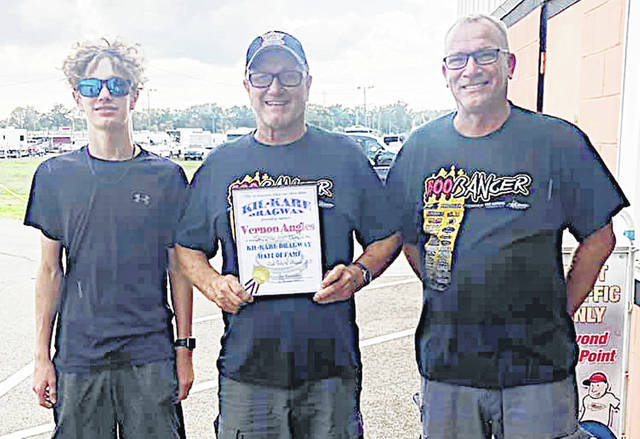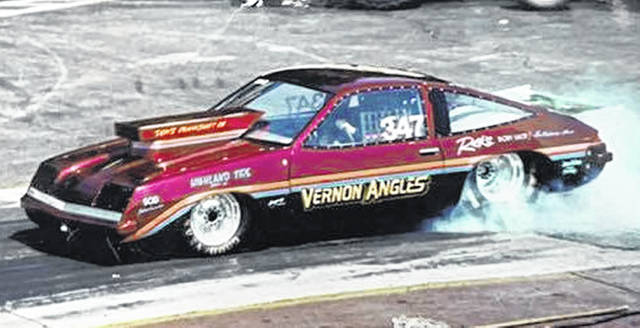

Though drag racing has changed since the mid-1960s, there has been one constant over the last six decades: at least one member of the Angles family has been in the driver’s seat of a dragster, barreling down a strip at 150+ miles per hour. After driving professionally for over 40 years, Hillsboro resident Vernon Angles was inducted into the Kil-Kare Raceway Hall of Fame on Aug. 22.
For Angles, drag racing is an exhilarating and spectacular sport, in which drivers speed down strips that can be 660 feet, 1,000 feet, or 1,320 feet in length.
“These cars with automatic transmissions leave at 5,000 RPM (the number of times an engine turns each minute) — most cars going down the road will never see 5,000 RPM,” Angles said. “The G-force is, like, four times as strong as the Beast at Kings Island. You don’t breathe, you don’t do anything — you’re planted so hard. You figure 154 miles per hour in 4-and-a-half seconds — 1, 2, 3, 4, you’re done. You went 154 miles per hour.”
Angles got his first taste of drag racing at 13, when he had the opportunity to learn from locals Doug and Meredith Chaney, who became his mentors. A few years later in 1965, Angles started driving.
“I used to be able to get a ride to Kil-Kare in the mid-60s. In ‘64, I would find a way to get there to watch drag racing,” Angles said. “They used to advertise it on WING — Steve Kirk, Dayton. He sounded like Wolfman Jack, and he would say, ‘Come on out to Kil-Kare Saturday night, and watch all these guys drag race. You got the gassers, the modifieds.’ And I just thought, ‘Man, here I am in Hillsboro.’”
Angles was not the only person in Hillsboro who was interested in hot rods in the 1960s and ’70s, though. By 1965, Angles had his own car — a 1956 Chevy that he converted into a hot rod — and he had found others who were interested in drag racing.
“Back then in Hillsboro, you were the top dog if you had the fastest car around because we did street racing all over the place — North Shore Drive, out on SR 73, Pidgeon Roost, Petersburg Pike, SR 138,” Angles said. “We raced everywhere — so long as we ran from the cops. They all knew we did it. We’d been caught, but we got away. They would tell you to stay there because they were chasing that guy who was going right there.”
With a chuckle, Angles remembered Hillsboro law enforcement’s attempts to dissuade the racers.
“We get to the end of Careytown Pike, and there was a cop sitting there in a 1956 Ford. Old Willard [Parr] and Earl Hughes get out and say, ‘You might outrun our cruiser, but you ain’t going to outrun these radios,’” Angles said. “They let us off because Earl knew Dad from working down at the Snow Hill station, and Willard knew Dad and Mom and everybody. [They said,] ‘You guys don’t do it again — just quit doing that crap.’”
And they would return to the back roads to drag race again the following week.
“They all knew we were drag racing — it was better than being drunk and driving that way,” Angles said. “There were a bunch of us who did it. They just wanted us to be safe.”
Five years later in 1970, Angles debuted at Kil-Kare, but he was not able to drive professionally due to the cost.
“I used to have to build transmissions for people in the evening just to be able to afford this habit,” Angles said. “It’s a very expensive habit. If you blow an engine, it’s $30,000, $40,000 to replace it.”
In the meantime, Angles drove whenever and however he could.
“Starting out when Brent (Angles’ son) was 4 months old, we’d pull up to the drag strip, and I’d jack the car up, put a set of cheater slicks (tires used in drag racing that are smoother than street tires used on passenger cars) on it, let it back down. Brent’s mom would pick him up and walk to the starting line, which was a quarter-mile away. I’d make a pass, and she’d walk back,” Angles said. “We got done, jacked it back up, put the street tires on it, and drove home. That’s how it was back then. It was our family car, but it was a fast race car.”
Angles started his own home repair business in 1973, and by 1979, he was able to begin racing professionally.
Angles typically competed in bracket races, where one car leaves and another car must chase the first, catch it, pass it, and win.
Before each race, the drivers must enter the time they estimate it will take them to travel down the strip. Drivers cannot win if they “break out,” or go faster than their projected time.
Angles leaned forward and said, “These races aren’t won or lost by seconds, they’re not won or lost by hundredths of seconds — these races are won or lost by ten-thousandths of a second.”
This means that drivers can lose a race by as little as an inch.
Bracket racing has changed since Angles began driving, however. In the mid-1960s and ’70s, Angles had to manually calculate his time and acceleration — now the process is almost completely computerized and automated.
“You could almost be in the stands and remote-control [the car]. All you do is release a button,” Angles said. “It leaves on its own, the accelerator comes on on its own, it shifts on its own — everything’s done automatically. The only thing you have to do manually is pull the parachute if something happens.”
Angles also has machines that calculate his time based on atmospherical factors, such as air quality, temperature and humidity.
As the machines involved in bracket racing became more complex and the cost to build modern dragsters’ engines increased, Angles stopped building the motors for his cars.
“We used to build all of our motors, but we have them all professionally built now. It got to where I didn’t have the machinery or the intelligence to keep up with the Joneses,” Angles said. “I used to leave the starting line with a clutch or a foot break. When you saw that last yellow [light], you had to determine if you were going to leave when it was coming on, when it was bright, or when it was going off. They gave you a ticket [that told you] how fast you went; the ticket now tells you how good you were — why you won or why you lost. It tells you how quick you went 60 feet — it tells you everything. The data today is so amazing you wouldn’t believe it.”
Angles has spent over four decades working towards the weekends, when he travels to raceways throughout Ohio, Kentucky, Indiana and Tennessee.
“The cars, the noise, the shifting of gears, the squeal of tires — to this day, there’s nothing better than the smell of burnt rubber and race fuel,” Angles said.
When asked about the highlights of his career as a professional drag racer, Angles smiled and said, “I can’t pick. It was all good.”
Though Angles, now 71, maintains his National Hot Rod Association (NHRA) membership and racing license, he has not driven in four years.
Instead, Angles watches his son Brent, now 50, and grandson Lex.
During the week, Angles works on residential and commercial properties throughout the region, but each Friday afternoon, Angles, Brent and Lex load up Brent’s and Lex’s cars, a golf cart, Lex’s scooter, 55 to 60 gallons of alcohol to fuel the cars, and two refrigerators’ worth of food and head for the next drag racing event.
Brent has been successful in his own career. According to Angles, other racers do not want to race Brent in early rounds because they know he will win.
Angles has also enjoyed watching Lex fall in love with drag racing.
“I wish I had that picture the first time he got out of the car — it was so cool. He was just real happy and excited. He loved it,” Angles said. “We were hoping he would like it. He was also getting ready to play baseball. He liked baseball, but he also liked drag racing, and drag racing takes your weekend. He chose drag racing.”
Lex has been driving in a junior division since he was 8 years old. Since then, Lex has found other racers his age, whom Angles affectionately referred to as his grandson’s family.
Now 16, Lex is preparing to leave the junior division.
“We’re going to sell the junior [car], and he’ll start driving the Beretta next year,” Angles said. “We’re taking the motor out and putting a little bitty motor in it. It’ll go 6.50 (seconds) — he goes 7.90 in the eighth-mile right now at 90 miles per hour in the junior — so we’re going to take that big motor out and put a little motor in for him.”
On Friday, the trio headed to Lucas Oil Raceway in Indianapolis for the NHRA U.S. Nationals.
Reach McKenzie Caldwell at 937-402-2570.



